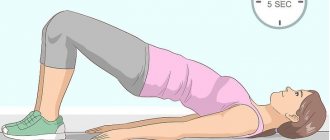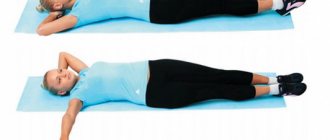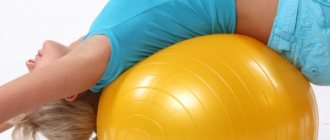When is it safe to have sex after giving birth?
In most cases, a mother can return to sexual activity after the birth of a child 6-8 weeks after the birth of the baby. During this time, all wound surfaces and sutures heal (if there were ruptures or incisions were made), reverse development (reduction in size) of all organs that changed during pregnancy occurs (with the exception of the mammary glands, which increase after childbirth), and the gaping of the cervix decreases . During the first 4-6 weeks after birth, the mother experiences vaginal bleeding - lochia, the color of which gradually changes from red to brownish. Abstinence from vaginal and anal sex during this period allows all wounds to heal without complications and avoid wound infection. Also during this period, the normal tone of the muscles of the vagina and perineum is usually restored. By 12 weeks after birth, ¾ of all couples return to vaginal sex. 1 year after the birth of a child, sexual relations resume in almost 100% of couples.
What happens during the operation?
During a caesarean section, the fetus is removed by making an incision in the abdominal wall and uterus. Rehabilitation of the uterus takes about 8 weeks. There are complications that slow down this process: trauma, swelling, hemorrhages in the suture area, etc. The incision is made in the lower segment of the uterus, which consists of muscle tissue and almost does not include blood vessels. The use of synthetic absorbable threads allows the edges of the wound to remain on the uterus for a long time. This way the healing process takes place most optimally and a scar is formed on the uterus. This is important for subsequent births.
After cesarean section, broad-spectrum antibiotics are used to avoid the development of any infectious diseases. This reduces immunity and suppresses beneficial intestinal microflora.
There are two types of seams:
- Horizontal/cosmetic. Accurate, performed during a pre-planned cesarean section. Recovery takes 2-2.5 months. With light loads, you can get into shape in 4-5 months.
- Vertical. Performed in an emergency situation, not thought out in advance. The result is severely damaged muscles. To achieve a flat stomach you will have to put in a lot of effort. Sometimes you have to use a laser to polish the scar. Physical exercise is allowed one year after surgery.
Visit a gynecologist before resuming sexual activity after childbirth!
Before starting to have traditional penetrative sex with a partner, it is advisable for the mother to visit a gynecologist to assess the condition of the cervix and the uterus itself, the healing of sutures and tears, and take a smear for flora. After the doctor’s approval, you can return to your usual sexual relationships with your partner without fears or doubts.
In mothers who give birth via cesarean section, the vaginal walls do not stretch due to the lack of passage of the baby through the birth canal. At the same time, recovery of the uterus after the incision occurs more slowly than after traditional childbirth. It will also take time for healing and the formation of a full-fledged scar on the abdomen.
Extravaginal forms of sex may be acceptable in the earlier period after childbirth: it all depends on the well-being and desires of the young mother.
How does a post-operative bandage help?
The product fits snugly to the body and supports the internal organs in a healthy position. This prevents them from moving, reduces swelling and prevents the appearance of hematomas. The bandage after cesarean section protects postoperative sutures and ensures their rapid scarring. Certain product models prevent the occurrence of hernias and prevent infection of sutures.
With the help of a bandage, the elasticity of the skin is restored. And the load will be distributed evenly across the back, thereby eliminating discomfort and pain in this area while walking. The skin is also quickly restored and the chance of the formation of hernias, swelling, and hematomas in the abdominal area is reduced.
Pain during intercourse in a nursing mother
Feeling pain due to vaginal spasm and insufficiently moistened vaginal mucosa is one of the most common problems during sex in the postpartum period and during breastfeeding. For most women, these problems disappear within a few months after giving birth. But every fifth woman continues to have sex through pain until one and a half years after giving birth. If this happens to you, know that you are not a bad wife, there is nothing wrong with your body, you are not alone in this problem, and it will resolve over time, just like hundreds of millions of other women.
Feel free to tell your partner about the problem of vaginal dryness and offer to include in the program long-term foreplay and the use of a water-soluble neutral lubrication gel, applying which to the partner’s penis or inside the vagina can be turned into a separate sensual entertainment.
Sex and postpartum depression
Decreased mood, postpartum asthenia or postpartum depression can create significant problems in the form of a decrease or disappearance of sexual desire.
True postpartum depression requires medication under the guidance of a psychiatrist. Depression is defined as having a decrease in mood for 2 weeks or more, loss of the ability to experience pleasure (not just sexual pleasure) or loss of previous interests, and a decrease in overall activity. In addition to these main signs, sleep and appetite may be disturbed, feelings of guilt may arise, thoughts of worthlessness and possible suicide may appear. In this case, it is necessary to immediately consult a doctor for help, since real depression does not go away on its own.
What to do if your partner wants sex, but you don’t?
Talk openly with your partner about how you are feeling and explain to him that decreased sexual desire is a natural but temporary response of a woman's body to having a baby and breastfeeding. Explain to him that you understand that he feels rejected, may have low self-esteem, and is worried about possible further sexual disharmony. Tell him about the changes in female physiology and that everything will return to normal after a certain period of time: from several months to a year and a half (let him sit during this conversation). Invite your partner to satisfy his intimate needs in alternative extravaginal ways that can be very pleasurable for him. However, remember that sex under pressure from a partner is a form of domestic violence and sex should be pleasure for both partners, and not a “repayment of marital debt” or a boring routine for one of the partners.
Full vaginal penetration is only one possible form of sex, and there are many other forms that are suitable during breastfeeding to maintain mutual sexual pleasure. Gentle stimulation of the most sensitive erotic zones of a young mother can give her no less, if not more, pleasure compared to traditional sex. Mutual masturbation, oral sex and sex toys can also be good ideas for intimacy during this difficult period. Tender words and hugs can also go a long way to convey love and emotion. By sharing your concerns and being honest with each other, you can resolve this delicate issue together. Intimacy is not just about sex. Don’t forget to spend time together, don’t become completely immersed in caring for the child, forgetting about your husband. Walking together, unexpected kisses and hugs, fleeting erotic episodes will help a man maintain faith in himself and in the prospects of your relationship.
How to make sexual relations more enjoyable during the breastfeeding period?
- To restart your sexual relationship, try simply hugging first to get used to sexual touching.
- Do not rush. Enjoy each other's bodies and engage in lengthy foreplay without expecting it to lead to full-on penetrative sex.
- For vaginal dryness, use a neutral, water-soluble intimate gel. Do not use fat-based ointments.
- If you're worried that penetrative sex will be painful, explore your vagina first with clean, lubricated fingers, or latex gloves and a lubricated condom.
- When you feel ready for sex, try not to rush things. It should be natural and both partners should feel ready and completely aroused. Try a position that does not put too much pressure on areas of increased soreness or sensitivity. Being on top of your partner, you can carefully control the speed and depth of penetration.
- If things become painful or uncomfortable, ask your partner to stop for a while. During the pause, the partner can engage in gentle stimulation of the clitoris. Once you feel aroused, you can resume traditional sex.
- When having sex while your child is sleeping, be prepared for the fact that the child will definitely wake up at the most inopportune time. Try to take it with humor and reschedule the continuation next time. Be patient as things will get easier once your baby starts sleeping through the night.
- Continue doing pelvic floor exercises to help restore muscle tone to your vagina. At the same time, this exercise can help you discover completely new sensations in vaginal sex.
- You need to eat well, drink plenty of fluids and rest whenever possible. Explain to your partner that the more household chores he takes on, the better you will rest, and the more colorful your lovemaking will be!
How long after cesarean can you play sports?
During the first week after cesarean section, you should not engage in sports at all, then you can increase the load in doses - presented in more detail in the table.
| Recovery period from surgery | Permissible load |
| First week after cesarean | Household procedures: feeding, swaddling, in the absence of complications, short walks for 20-30 minutes without carrying heavy objects, breathing exercises. |
| First month | Leisurely walks in the fresh air, household procedures, except for intensive cleaning with emphasis on knees and moving heavy objects. Breathing exercises are expanded with exercises that correct the condition of the abdominal muscles; light exercises aimed at strengthening the abdominal muscles are allowed for 15-20 minutes a day. Control of secretions, heart function and breathing is important. |
| 4-5 months | Walking in the fresh air at a medium pace, Pilates, yoga, water aerobics at medium intensity. |
| 6 months | The range of activities expands to include dancing, light aerobics, corrective sets of exercises for different muscle groups without weights, and gymnastics. |
| 1 year | Ordinary physical activity, exercise in the gym, running, and cardio are allowed if there are no complications after surgery. |
Reasons why you can’t start playing sports right away
After a caesarean section, women strive to start playing sports as soon as possible, but after the operation, during the first few weeks, the most active and intense healing processes take place: both on the surface of the skin and inside the small pelvis on the uterus, the suture heals and a scar forms.
The hormonal system is also restored, lactation begins, and lochia is released from the uterine cavity. All this requires a careful regime of work and rest for the woman in labor, as well as exertion of all the forces of the body.
During surgery, muscles are most often pushed apart in a blunt manner rather than cut, which helps to quickly restore tone when they are adequately loaded.
Physical activity in the previous prenatal version will be a great stress, in response to which the release of stress hormones, including cortisol, will increase, which will lead to disruption of the metabolic foundations of recovery and will aggravate the load on all organs and systems.
During the first week after cesarean section, you should not engage in sports at all. Afterwards, the most stringent restrictions apply to exercises with weights, as well as all types of impact loads, jumping and shaking of the body; you cannot put a pronounced load on the heart in the form of long runs or work in the gym. During the first year, physical fitness is restored without negative effects, if all movement restrictions and recommendations are followed.
We recommend reading about what exercises you can do after a cesarean section. From the article you will learn how long after a CS you can start training, permitted and prohibited exercises, contraindications to training. And here is more information about when you can pump up your abs after a caesarean section.
When to start, goals and objectives
You can start increasing your physical activity on the first day by walking around the room and doing breathing exercises. For 6-12 hours after surgery, you should refrain from any activity and lie down on the bed to avoid complications of anesthesia. Then you can get up little by little and take care of the child. In the absence of contraindications, breastfeeding is allowed with the help of nurses or relatives, since the woman should not lift heavy objects.
You can do the following breathing exercises:
- inhale slowly for 3 counts and exhale slowly;
- take a deep breath and exhale long for several counts;
- inhale and hold your breath for a few seconds.
Breathing exercises should be performed for a short period of time; 2-3 minutes in the first days after birth will be enough.
Early activation of a woman in labor is needed to:
- accelerate tissue restoration;
- activate metabolism;
- optimize the function of the heart and blood vessels;
- improve the psychological state of a woman.
Physical inactivity in the early postoperative period in the absence of complications has a harmful effect on a woman’s body, and physical activity promotes a speedy recovery. To achieve this, the following tasks are set:
- expand physical activity;
- improve breathing rhythm;
- restore coordination after anesthesia;
- reduce the risk of stagnation in the pelvis;
- promote early contact between mother and child.
Diaphragmatic breathing
Intensity, features of the first training sessions
The first workouts after surgery should be low intensity. You should monitor your breathing and heartbeat: it is permissible to increase the heart rate by 20-25 beats above the usual numbers if there are no diseases of the cardiovascular system. Blood pressure often increases during pregnancy, which should also be taken into account when starting exercise. It is necessary to achieve stable blood pressure before increasing the load on the body.
Also, you should not give any weights; classes and exercises are allowed only with your own weight. Walking in the fresh air in the mode of light and then intense walking plays a big role in the motor mode. The duration of walks should be increased gradually. It is optimal to achieve at least 150 minutes of fresh air per week.
You can do simple exercises at home, starting from 5 to 30 minutes. An approximate complex may consist of the following options:
- lie on your back, bend your knees, lift your pelvis up, squeezing your buttocks - 15 times, 2-3 approaches;
- squat, knees should not go past your toes, arms extended forward – 10 times, 2-3 approaches;
- stand up, bend your arms and place them on your belt, slowly bend your body in one direction, then in the other - 15 times in each direction, 2-3 approaches;
- from the same starting position, tilt the body forward and backward to moderate tension - 10 times, 1-2 approaches;
- rotate your hips first in one direction, then in the other - 30 seconds of alternating rotations;
- lie on your back, raise your legs bent at the knees to your chest - 10 times, 2-3 approaches;
- in a lying position, squeeze and relax the pelvic floor muscles (Kegel exercises) - 10 times, 2-3 approaches;
- do a plank (1-2 months after birth), gradually increasing the duration of the plank.
Watch the video about a set of exercises after cesarean section:
Coordinate all exercises with breathing: relax or rise as you inhale, and give the main load as you exhale. At the same time, make sure that you do not feel dizzy and that your heart rate does not increase. It should be remembered that all exercises must be performed in special bandages.
When to stop
Sometimes you need to stop exercising if the unwanted reactions presented in the table begin in the body.
| Early | Late |
|
|
Such reactions can develop both during the training itself and between loads, which makes it possible to divide the symptoms into early and late. The early ones are associated with the reaction of the autonomic circulatory system, breathing, and cerebral circulation. The later ones are realized through changes in recovery processes, the development of hormonal imbalances and stress damage.
If early signs occur during or immediately after exercise, the load should be stopped. You should observe the condition for several days, then you can resume exercises, reducing their pace. Such symptoms indicate a discrepancy between the load and the current state.
Late complications and symptoms that develop over a long period of exercise indicate a change in the repair processes: metabolic recovery mechanisms are disrupted in the body, bleeding, anemia, inflammation, and disruption of endocrine regulation due to increased load may develop. In this case, classes should be stopped until the pathological cause of the symptoms is eliminated.
Contraindications
There are certain contraindications to starting physical exercise. They are divided into pathologies of the reproductive system, complications of cesarean section and diseases of other organs and systems.
| Diseases of the genital organs | Diseases of other organs and systems | Complications of cesarean section |
|
|
|
In these cases, physical activity should be significantly limited depending on the severity of the disease.
Call a breastfeeding specialist to your home
At the group's children's medical centers, we know that the most convenient place for breastfeeding consultations is your own cozy home:
- A specialist will come to you at a convenient time. You don't have to go to the clinic and wait in line. Consultations can also be held directly in the maternity hospital (if visits are permissible) or in a medical center.
- A familiar home environment makes consultation easier for both mother and child.
- At home, the consultant will be able to devote more time to both the child and the parents.
- The consultant is always a phone call away: day and night (at night you can call the contact center or write to the consultant, the consultant will answer as soon as possible), on weekdays and on weekends.
- Support from a specialist is not one-time consultations, but accompaniment: the consultant will visit the mother and baby again, if necessary, after 2-4 weeks to check how feeding is going and the baby’s weight gain.
In addition to calling a breastfeeding specialist to your home, you can call doctors of the main specialties: pediatrician, surgeon, allergist, urologist, pulmonologist, hematologist, dermatologist, ophthalmologist, ENT doctor, orthopedist, gastroenterologist and osteopath. You can also take tests, perform physiotherapy and massage at home. Infant swimming consultants can advise you at home and conduct a master class.
Find out about the special offer “Comprehensive examination at home”: the convenience of this program is that you can choose from a list of pediatric doctors exactly those specialists that your child needs and an individual set of medical services with a 20% discount!
Allowed sports
You should pay attention to the following exercises:
Breathing exercises are very useful. One of the options:
- Take 10 breaths with your chest. The stomach remains motionless;
- take 10 breaths in and out with your stomach, carefully holding the seam;
- Pull the perineum and abdominal muscles inward 10 times, very carefully and gently.
Frequent walks in the fresh air are beneficial for both children and mothers. This gives a certain load, but you don’t have to strain your muscles too much.
IMPORTANT! Exercises that can be done will be given by a physical therapy doctor during a consultation in the maternity hospital. This complex is useful; it can be performed 2 weeks after discharge from the hospital. The exercises are aimed at accelerating blood circulation and tissue regeneration.
Advantages of calling Virilis Group specialists to your home
- Travel to any area of the city and region without restrictions.
- No insurance, registration or citizenship is required to receive medical care.
- Providing assistance to children of any age.
- Experience in responsible treatment of children in St. Petersburg since 1991.
- 6 own children's medical centers with 650 specialists in 49 specialties.
- Possibility of diagnostics and continuation of treatment in our clinics.
- Coordination with other doctors of the VIRILIS Group of Companies clinics: we are a single team, and not individual doctors from a “mobile” clinic.
- 24/7 contact center.
- Issuance of official medical certificates and documents.
- Possibility of purchasing a package of a comprehensive medical program for a child, including the “Emergency Care” and “Comprehensive Examination at Home” packages.
- Special medical programs for newborns and infants.










